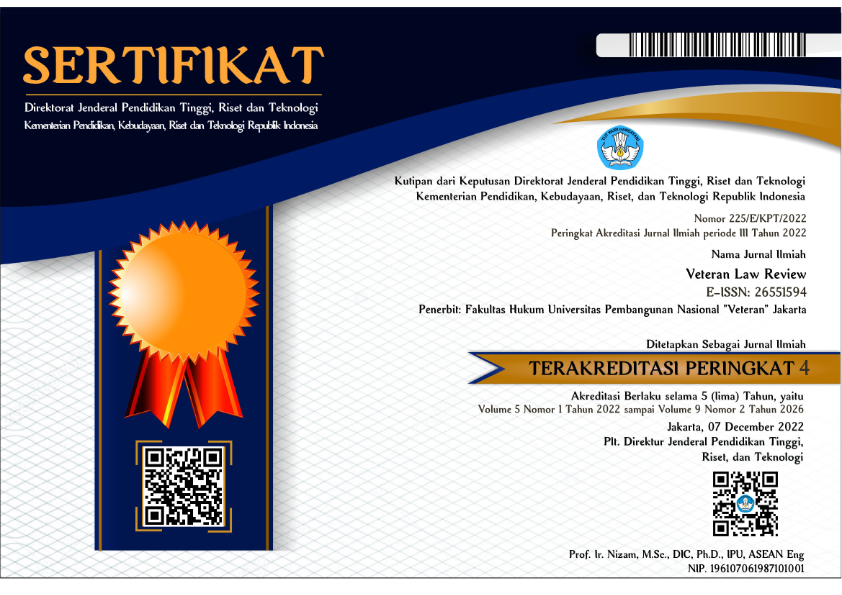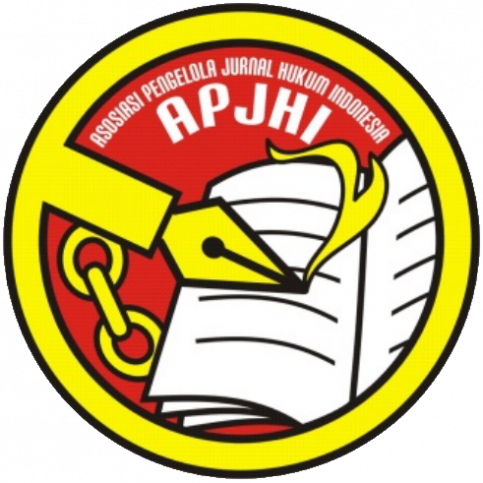Bisphenol A (BPA) Content in Food and Beverage Plastic Packaging Perspective of Food Law and Consumer Protection
DOI:
https://doi.org/10.35586/velrev.v6i1.4850Keywords:
Food and Beverage, Food Law, Consumer ProtectionAbstract
The packaging sector is an important industry. Packaging is used as a material to protect goods from external contamination. There are various kinds of packaging, one of which is often used is plastic packaging. In plastic packaging there is one of the BPA materials used in the plastic manufacturing process. This BPA content has the potential to be released and mixed with packaged food and drinks. While BPA is a content that can cause various diseases such as cancer. This study aims to determine the content of BPA in plastic packaging seen from the Law on Food and the Law on Consumer Protection. This study uses normative legal research that is descriptive analytical with a qualitative approach to primary data, secondary data and tertiary data which includes the content and structure of positive law. It is used as a reference in reviewing legal issues that are the object of study. The results of the study show that the BPA content in plastic packaging does not meet the packaging quality standards in accordance with the Law on Food. The Law on Food states that food packaging must use materials that do not endanger health. The Law on Consumer Protection also states that one of the rights of consumers is to have security and safety in consuming goods and services. The content of BPA which can cause various diseases is clearly not in accordance with the clauses in the Consumer Protection Act.Downloads
References
Amiruddin dan Zainal Asikin. (2004). Pengantar Metode Penelitian Hukum. Jakarta: Rajawali Press.
DGD. Dharma Santhi dkk. (2016). “Faktor-Faktor Yang Berhubungan Dengan Keberadaan Bahan Berbahaya Bisphenol A (BPA) Yang Terkandung Dalam Kontainer Plastik Makanan dan Minuman”. Dalam Skripisi Fakultas Kedokteran Universitas Udayana.
I Gede Putu Suardana dkk. (2019). “Aksiologi Packaging” Perspektif Small Bisnis and Customer Di Sidoarjo”. DIE Jurnal Ekonomi & Manajemen. 10(2).
I Nyoman Gede Suyasa dkk. (2018). “Faktor-Faktor Yang Berhubungan Dengan Keberadaan Bahan Berbahaya Bisphenol A (BPA) Yang Terkandung Dalam Kontainer Plastik Makanan dan Minuman”. Jurnal Skala Husada. 15(1).
Ilmiawati, Cimi dkk. (2017). “Edukasi Pemakaian Plastik Sebagai Kemasan Makanan dan Minuman Serta Risikonya Terhadap Kesehatan Pada Komunitas Di Kecamatan Bungus Teluk Kabung, Padang”. Logista: Jurnal Ilmiah Pengabdian kepada Masyarakat. 1(1).
Kahfi, Ashabul. (2018). “Aspek Hukum Perlindungan Konsumen Muslim di Indonesia”. Jurisprudentie. 5(1).
Miru, Ahmadi dan Sutarman Yudo. (2004). Hukum Perlindungan Konsumen. Jakarta: PT Raja Grafindo Persada.
Moh. Abdul Latif. “Urgensi dan Eksistensi Undang-Undang Perlindungan Konsumen Terhadap Konsumen”. Jurnal Yudisia.
Musatakllima. (2021). “Self Declare Produk Halal”. De Jure: Jurnal Hukum Syariah. 13(1).
Nurcholifah, Ita. (2012). Manajemen Pemasaran. Pontianak: Stain Pontianak Press.
Rahmayani, Sri dan T. Haflisyah. (2018). “Perlindungan Konsumen Terhadap Penggunaan Produk Styrofoam Sebagai Kemasan Pangan Di Kota Banda Aceh”. Jurnal Ilmiah Mahasiswa. 2 (1).
Susanto, Happy. (2008). Hak-Hak Konsumen Jika Dirugikan. Jakarta: Visi Media.
Undang-Undang Nomor 8 Tahun 1999 Tentang Hak Konsumen (Lembaran Negara tahun 1999 Nomor 22, Tambahan Lembaran Negara Nomor 3821).
Undang-Undang Nomor. 18 Tahun 2012 tentang Pangan (Lembaran Negara tahun 2012 Nomor 227, Tambahan Lembaran Negara Nomor 5360).
Waluyo, Bambang. (1996). Penelitian Hukum Dalam Praktek. Jakarta: Sinar Grafika.
Widiati, Ari. (2019). “Peranan Kemasan (Packaging) Dalam Meningkatkan Pemasaran Produk Usaha Mikro Kecil Menengah (UMKM) Di “Mas Pack” Terminal Kemasan Pontianak”. Jurnal Audit dan Akuntansi Fakultas Ekonomi dan Bisnis Universitas Tanjungpura. 8(2).
Downloads
Published
How to Cite
Issue
Section
License
Copyright (c) 2023 Veteran Law Review

This work is licensed under a Creative Commons Attribution-ShareAlike 4.0 International License.
Copyright (c) 2022 Veteran Law Review Journal
Veteran Law Review © 2022 by Faculty of Law Universitas Pembangunan Nasional "Veteran" Jakarta is licensed under Creative Commons Attribution 4.0 International

1. License
The non-commercial use of the article will be governed by the Creative Commons Attribution license as currently displayed on Creative Commons Attribution 4.0 International.
2. Author(s)' Warranties
The author warrants that the article is original, written by the stated author(s), has not been published before, contains no unlawful statements, does not infringe the rights of others, is subject to copyright that is vested exclusively in the author, and free of any third party rights, and that any necessary written permissions to quote from other sources have been obtained by the author(s).
3. User/Public Rights
VELREV's spirit is to disseminate articles published are as free as possible. Under the Creative Commons Attribution-ShareAlike 4.0 International License. VELREV permits users to copy, distribute, display, and perform the work for non-commercial purposes only. Users will also need to attribute authors and VELREV to distributing works in the journal and other media of publications.
4. Rights of Authors
Authors retain all their rights to the published works, such as (but not limited to) the following rights;
- Reproduce the work
- Prepare derivative works based upon the work
- Distribute copies of the work
- Perform the work publicly
- Display the work publicly
- Copyright and other proprietary rights relating to the article, such as patent rights,
- The right to self-archive the article,
- The right to enter into separate, additional contractual arrangements for the non-exclusive distribution of the article's published version (e.g., post it to an institutional repository or publish it in a book), with an acknowledgement of its initial publication in this journal (Veteran Law Review).
5. Co-Authorship
If the article was jointly prepared by more than one author, any author submitting the manuscript warrants that he/she has been authorized by all co-authors to be agreed on this copyright and license notice (agreement) on their behalf, and agrees to inform his/her co-authors of the terms of this policy. VELREV will not be held liable for anything that may arise due to the author's internal dispute. VELREV will only communicate with the corresponding author.
6. Royalties
Being an open accessed journal and disseminating articles for free under the Creative Commons license term mentioned, author(s) are aware that VELREV entitles the author(s) to no royalties or other fees.
7. Miscellaneous
VELREV will publish the article (or have it published) in the journal if the article’s editorial process is successfully completed. JOSI's editors may modify the article to a style of punctuation, spelling, capitalization, referencing, and usage that deems appropriate. The author acknowledges that the article may be published so that it will be publicly accessible and such access will be free of charge for the readers as mentioned in point 3.

















